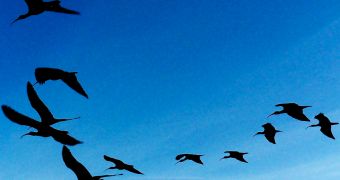Scientists at the Royal Veterinary College in London, led by researchers Steven Portugal, were recently able to gain a deeper understanding of why many bird species prefer to fly in V-shaped formations. The debate on this issue has been raging on in the international scientific community for decades.
Results of the investigation appear in a paper published in the latest issue of the top scientific journal Nature. The team argues that these carefully-planned formations help all birds in the flock – except the one leading the way – catch at least a small amount of lift from the birds ahead.
While this may not seem all that important, birds make significant energy savings over the course of long or very long migratory flights, which often take them across entire continents. This was first theorized nearly a century ago, but investigators lacked proof, until now.
With recent advancements in technology and miniaturization, it became possible for scientists to mount complex measuring equipment on the back of flying birds, to monitor their positions and vital signs over long journeys. This enabled accurate readings of the benefits of flying in V formations.
“All it was, was theory – no one was ever actually able to measure anything,” Portugal explains. The expert leads an RVC lab that designed and built special measuring instrumentation for this research.
In addition to establishing the birds' positions at all time, via a built-in GPS transponder, these tools are also able to use onboard accelerometers to measure the amount of flapping and forward motion each animal performs at any given time, NPR reports.
The study was carried out on a flock of Northern bald ibises. These birds disappeared from Europe nearly three centuries ago, and researchers have been trying to reintroduce them ever since. Scientists are acting as foster parents for the birds, teaching them their old migratory routes.
At birth, each of the ibises in this population receives a human foster parent, so they are accustomed to humans being around them. This made it easier for researchers to attach and remove their equipment, since this was the only way to collect the data.
“When they first start flying around […] they will naturally put themselves in a [clumsy] V formation. But it seems like with practice, they gradually get better and better at flying in a good V,” Portugal says.
The team concluded that each of the birds gets a little bit of lift from the tips of wings on the birds ahead. “Furthermore, when they're in that position, they time wing beats perfectly,” the expert adds.
“So they don't just sit there passively hoping to get some of the good air from the bird in front,” Portugal concludes. Despite these data, he acknowledges that more work needs to be done in order to finally settle the mystery of V-shaped bird formations.

 14 DAY TRIAL //
14 DAY TRIAL //